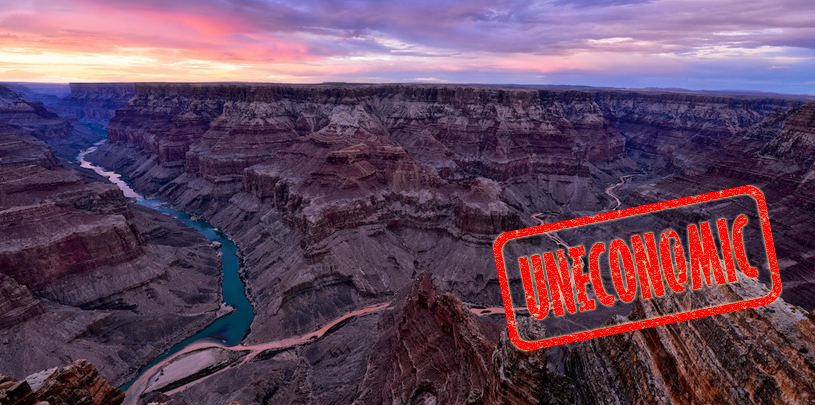
 by Roger Clark, Grand Canyon Director
by Roger Clark, Grand Canyon Director
Consider the business of mining public lands for private profit: speculators from around the world can claim ownership of uranium ore wherever it’s located on public land in the United States. They can then mine the deposit for however long it takes, despite risking potentially devastating radioactive contamination. Not even the Grand Canyon is safe.
In the case of the Canyon uranium mine – located within miles of the Grand Canyon’s south rim – the process of exploratory drilling began nearly four decades ago. In the early 1980s, a Canadian company moved heavy machinery into the Kaibab National Forest, where ancient pine groves grace campsites popular for hunting elk and for easy access to Grand Canyon.
After several years of punching test holes into rock strata below, the uranium company hit a sufficient amount of ore to make mining lucrative—or so they thought. The U.S. Forest Service reviewed potential environmental impacts and, after considerable public opposition, permitted the private company to occupy public lands indefinitely.
Specifically, the Forest Service granted the company permission, in perpetuity, to fence off an area the size of a big-box parking lot and turn a lovely meadow into an industrial park, displacing recreationists, wildlife, and even cattle. For its exclusive use of prime public land located next to Grand Canyon National Park, the company pays no fees to the U.S. Treasury—not then, not now, not even after valuable ore is eventually hauled to Utah for milling into “yellow cake.” Under current market conditions, owners say they will begin trucking ore to the mill in 2016, 40 years after the Forest Service permit was issued.
Even with free use of public land, it turned out uranium mining could not pay for itself back then, much less turn a profit. Two years after Canyon Mine was opened, uranium prices plummeted and its owners shut the gates and walked away, well before reaching the ore deposit a thousand feet below. Drilling was just too expensive. The mine was sold to a series of foreign companies speculating in hopes of uranium prices rising again. Sure enough, global prices for yellow cake peaked again in 2007.
Canyon Mine’s owners started preparing the site for reopening under its 1986 permit and without the Forest Service requiring any new review of environmental or economic impacts to the Grand Canyon region. But the global uranium market took a dive after the 2011 Fukushima Daiichi nuclear disaster– slowing the push for re-opening operations at Canyon Mine.
In 2012, former Secretary of the Interior Ken Salazar declared a 20 year ban on new uranium mining on 1.1 million acres of land in the Grand Canyon region. For Canyon Mine to re-start operations, the Forest Service had to find that the mine was economically viable. Although the agency declared that Canyon Mine met that threshold, the agency failed to include the costs of environmental compliance and clean-up in the cost of doing business. This is a serious omission: the first phase of clean-up of the nearby Orphan uranium mine has cost taxpayers more than $15 million.
The Forest Service also concluded, yet again, that the mine’s 36-year old permit needed no revisions nor a new environmental review, despite new evidence of groundwater contamination near uranium mines and impacts to the Red Butte “traditional cultural property” held sacred by the Havasupai and other native peoples.
Canyon Mine did reopen in 2013. Miners managed to sink Canyon Mine’s shaft a few hundred more feet, hitting a perched aquifer and forcing them to pump water from the mine shaft into a lined catchment basin on the surface. Canyon Mine’s owners announced a “business decision” to close it, “temporarily,” less than a year after the Forest Service erroneously decreed its economic viability. Under current market conditions, the mine’s owners now estimate they will begin trucking ore to the mill in 2016 – 40 years after the Forest Service permit was issued. Even more difficult to believe, the Canyon Mine is being allowed to operate under the authority of the initial, unchanged, and now-obsolete 1986 environmental review and mine permit.
Four decades of experience have shown that uranium mining around the Grand Canyon is uneconomic. It’s uneconomic for private companies and uneconomic for the American public, who see no benefit from royalties and are too often stuck with clean-up costs when companies go bankrupt – a pattern we have seen too often repeated at other uranium mines and mills across the Southwest.
While speculators may see their investments fall flat, those of us who actually live here face a much more dismal reality: the prospect of permanent radioactive contamination threatening Grand Canyon’s viability as the backbone of our region’s economy and as an internationally treasured landscape.
In response to such unnecessary, unsafe, and uneconomic risks, the Grand Canyon Trust and our allies are challenging agencies’ decisions in court, as well as petitioning for rule changes that would put reasonable time limits on when permits must be reviewed and revised. Periodic revisions, such as requiring precautionary practices like groundwater monitoring, will help protect public land and water from permanent harm.
Simply put, these common-sense changes make good economic sense for American taxpayers and regional residents who must ultimately bear the burden of uranium mining’s costly mess.
A small victory in the legal case challenging Daneros uranium mine, near Bears Ears National Monument.
Read MoreGroundwater pumping at a uranium mine near the Grand Canyon will affect the canyon's springs, scientists says.
Read MoreA rally in Salt Lake City followed by a spiritual walk in White Mesa demonstrate the Ute community's determination to see uranium mill close.
Read More